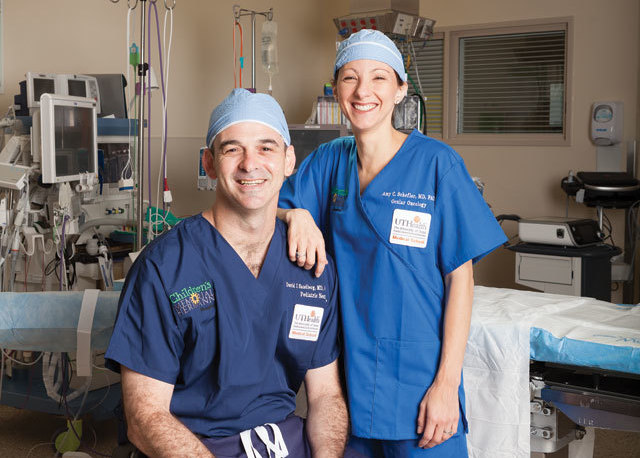Finding a Better Way to Target Children’s Cancer

Dr. Amy Schefler and Dr. David Sandberg of Children’s Memorial Hermann
In a world where the cure can be deadlier than the disease, a Houston medical power couple is finding new ways to deliver cancer medicine.
DRS. AMY SCHEFLER, a pediatric ocular oncologist, and David Sandberg, a pediatric neurosurgeon, are at the forefront of their respective fields, each having pioneered techniques that are changing the way children with cancer receive life-saving treatments.
“What we share, somewhat by chance,” says Sandberg, “is that both of us treat kids with cancer and both of us have seen the devastating effects of systemic chemotherapy—drugs that are given in high levels that circulate around the body and damage organs that are not affected by the cancer.”
Traditional chemo treatments flood the body with toxic chemicals, triggering a host of other problems, especially in young children—the development of secondary cancers, growth issues, hormonal issues, fertility issues, and other long-term effects rarely seen in adult patients—and sometimes even death. During the course of his fellowship, Sandberg says, “I saw kids dying of the treatment, not of the disease.” He, like Schefler, knew there had to be a better way. And they found one.
“Both of us are involved in local delivery to the target organ,” Sandberg explains. “She’s delivering drugs through the tiniest vessels that go to the retina,” where highly concentrated doses of chemo target retinoblastomas, rare ocular cancers most often seen in children. Sandberg, meanwhile, is “delivering drugs directly into the brain, where nobody’s done it before, to treat the most malignant brain tumors in children.” Between the two of them, these Children’s Memorial Hermann physicians (Dr. Sandberg is also affiliated with the Mischer Neuroscience Institute at Memorial Hermann) are offering some of the most highly specialized and effective cancer treatments in the world—all the while married to each other.
“We met on an airplane in 1998,” says Sandberg, as Schefler smiles fondly at the retelling. “I was a resident and she was a medical student.” Both are soft-spoken, calm, gentle. It’s easy to see how children and parents alike would find their demeanors soothing.
The attraction was apparently instantaneous, and a few years later the two found themselves dating seriously and living in New York while Schefler completed medical school and Sandberg his residency. It was there that Sandberg knew once and for all that Schefler was “the one.”
During the course of annual mission work in Honduras, Sandberg had encountered an eight-year-old girl with a brain tumor that was considered inoperable in her home country—but not in the US. He arranged for the girl, Marcela, and her mother to come to New York, where he gave up his apartment so they’d have a place to stay throughout the three-month-long treatment.
“I was a resident, I was never around,” recalls Sandberg, who’d make late-night pit stops into his apartment when he could to check on Marcela and her mother. “And I’d find Amy on the floor playing with this little girl and speaking Spanish. She was so sweet with this little girl, I thought, ‘Wow, this could be the mother of my children.’” The doctors married in 2003 and within a few years had begun a family of their own.
After stints in New York, Los Angeles, and Miami—Sandberg spent seven years in the latter performing clinical trials with pigs and non-human primates to prove his potentially revolutionary treatment for pediatric brain tumors did not damage the delicate brain stem—the couple moved their two children and their pediatric oncology research efforts to Houston two years ago. “This is such an incredible place to be,” Schefler says. “I think if you live here for a long time, you stop realizing what a bedrock of talent this place is.”
What’s also hard to find are two perfect jobs in the same city for two physicians whose fields are by their own definition “sub-specialized”—Schefler is one of a handful of physicians (and the first in Texas) to perform this targeted type of retinoblastoma treatment, and no one else on the planet is treating malignant brain tumors the way Sandberg and his team are. Small wonder then that Children’s Memorial Hermann needed what both doctors had to offer, giving each of them a team—which, in Sandberg’s case, includes doctors from UT Health and MD Anderson as well as Children’s Memorial Hermann—along with support and the funding necessary to continue vital research.
The couple continues to support each other while working to find ever healthier treatments for their tiny patients. “For both of us,” says Sandberg, “our work is based on the hypothesis that when we look back on the current era of giving systemic chemotherapy, hopefully we’re going to look back on it as a barbaric time.”
Their work has already begun to pay off. “What you do now can have an impact on the patient for many years,” says Schefler, whose hopes are already coming true. Marcela, the young Honduran girl whose life her husband saved, is now 21 and attending medical school. She is considering becoming a pediatrician.
(Houstonia magazine) September 1, 2014 By Katharine Shilcutt